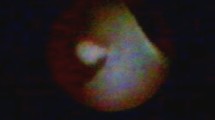Abstract
Background
Methylene blue injection of lesions often is inaccurate, and ductoscopic wire marking does not facilitate easy identification of lesions during microdochectomy in patients with pathologic nipple discharge. The authors designed a light-emitting wire that can be inserted into pathologic mammary ducts to facilitate intraoperative duct identification and evaluated the efficacy of this device in patients undergoing selective microdochectomy.
Methods
In this study, 69 patients being evaluated for pathologic discharge were randomized to undergo selective microdochectomy with either methylene blue pathologic duct marking or light-emitting wire pathologic duct marking. The patient clinical characteristics and surgical outcomes were compared and evaluated.
Results
Of the 69 study patients, 36 underwent selective microdochectomy guided by methylene blue injection, and 33 underwent light-emitting wire marking. No differences existed between the clinical and histologic characteristics or the diagnostic accuracies of the groups. In 11 (30.56 %) of the 36 patients who underwent methylene blue marking, the ducts ruptured after the methylene blue was injected, and normal tissue around the duct was stained. Light-emitting wire marking was associated with a shorter surgical time and smaller surgical specimens.
Conclusions
The use of light-emitting wire marking enabled selective microdochectomy of pathologic ducts under visual guidance. Resection volume was reduced, and blinded extended resection was avoided.

Similar content being viewed by others
References
Fisher CS, Margenthaler JA. A look into the ductoscope: its role in pathologic nipple discharge. Ann Surg Oncol. 2011;18:3187–91. doi:10.1245/s10434-011-1962-2.
Nakhlis F, Ahmadiyeh N, Lester S, Raza S, Lotfi P, Golshan M. Papilloma on core biopsy: excision vs observation. Ann Surg Oncol. 2015;22:1479–82. doi:10.1245/s10434-014-4091-x.
Foulkes RE, Heard G, Boyce T, Skyrme R, Holland PA, Gateley CA. Duct excision is still necessary to rule out breast cancer in patients presenting with spontaneous bloodstained nipple discharge. Int J Breast Cancer. 2011;2011:495315. doi:10.4061/2011/495315.
Balci FL, Feldman SM. Interventional ductoscopy for pathological nipple discharge. Ann Surg Oncol. 2013;20:3352–4. doi:10.1245/s10434-013-3181-5.
Montroni I, Santini D, Zucchini G, et al. Nipple discharge: is its significance as a risk factor for breast cancer fully understood? Observational study including 915 consecutive patients who underwent selective duct excision. Breast Cancer Res Treat. 2010;123:895–900. doi:10.1007/s10549-010-0815-1.
Zhu X, Xing C, Jin T, Cai L, Li J, Chen Q. A randomized controlled study of selective microdochectomy guided by ductoscopic wire marking or methylene blue injection. Am J Surg. 2011;201:221–5. doi:10.1016/j.amjsurg.2010.03.011.
Ling H, Liu GY, Lu JS, Fiberoptic ductoscopy-guided intraductal biopsy improve the diagnosis of nipple discharge. Breast J. 2009;15:168–75. doi:10.1111/j.1524-4741.2009.00692.x.
Khan SA, Mangat A, Rivers A, Revesz E, Susnik B, Hansen N. Office ductoscopy for surgical selection in women with pathologic nipple discharge. Ann Surg Oncol. 2011;18:3785–90. doi:10.1245/s10434-011-1791-3.
Hahn M, Fehm T, Solomayer EF, et al. Selective microdochectomy after ductoscopic wire marking in women with pathological nipple discharge. BMC Cancer. 2009;9:151–157. doi:10.1186/1471-2407-9-151.
Balci FL, Feldman SM. Exploring breast with therapeutic ductoscopy. Gland Surg. 2014;3:136–41. doi:10.3978/j.issn.2227-684X.
Seltzer MH. Breast complaints, biopsies, and cancer correlated with age in 10,000 consecutive new surgical referrals. Breast J. 2004;10:111–7.
Sabel MS, Helvie MA, Breslin T, et al. Is duct excision still necessary for all cases of suspicious nipple discharge? Breast J. 2012;18:157–62. doi:10.1111/j.1524-4741.2011.01207.x.
Fajdić J, Gotovac N, Glavić Z, Hrgović Z, Jonat W, Schem C. Microdochectomy in the management of pathologic nipple discharge. Arch Gynecol Obstet. 2011;283:851–4. doi:10.1007/s00404-010-1481-6.
Salhab M, Al Sarakbi W, Mokbel K. Skin and fat necrosis of the breast following methylene blue dye injection for sentinel node biopsy in a patient with breast cancer. Int Semin Surg Oncol. 2005;2:26–28. doi:10.1186/1477-7800-2-26.
Bleicher RJ, Kloth DD, Robinson D, Axelrod P. Inflammatory cutaneous adverse effects of methylene blue dye injection for lymphatic mapping/sentinel lymphadenectomy. J Surg Oncol. 2009;99:356–60. doi:10.1002/jso.21240.
Acknowledgment
This work was partly supported by the National Natural Science Foundation (No. 81201906), the Medical Research Project of the Health Department of Anhui Province (No. 13ZC007), and the Youth Doctor Fund of Anhui Medical University Provincial Hospital.
Conflict of Interest
There are no conflicts of interest.
Author information
Authors and Affiliations
Corresponding author
Additional information
Xiao-Peng Ma and Wei Wang contributed equally to this study as co-first author.
Rights and permissions
About this article
Cite this article
Ma, XP., Wang, W., Kong, Y. et al. A Novel Light-Emitting Wire Enhances the Marking and Visualization of Pathologic Mammary Ducts During Selective Microdochectomy. Ann Surg Oncol 23, 796–800 (2016). https://doi.org/10.1245/s10434-015-4919-z
Received:
Published:
Issue Date:
DOI: https://doi.org/10.1245/s10434-015-4919-z




